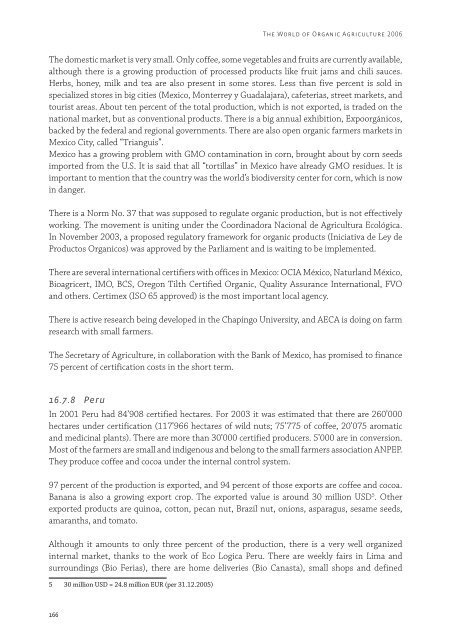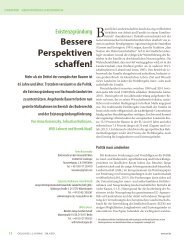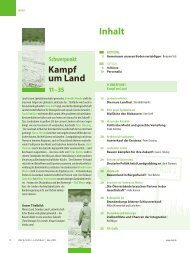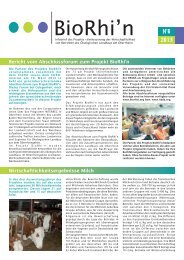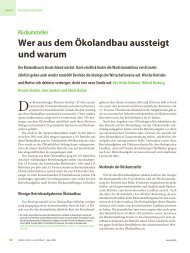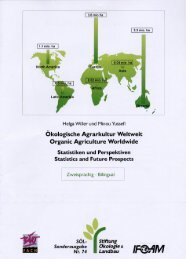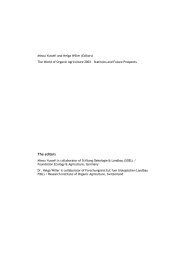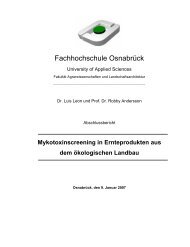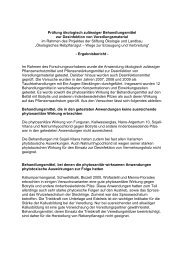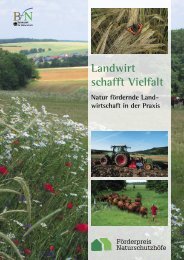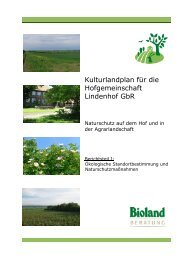the world of organic agriculture - Organic Eprints
the world of organic agriculture - Organic Eprints
the world of organic agriculture - Organic Eprints
Create successful ePaper yourself
Turn your PDF publications into a flip-book with our unique Google optimized e-Paper software.
166<br />
The World <strong>of</strong> <strong>Organic</strong> Agriculture 2006<br />
The domestic market is very small. Only c<strong>of</strong>fee, some vegetables and fruits are currently available,<br />
although <strong>the</strong>re is a growing production <strong>of</strong> processed products like fruit jams and chili sauces.<br />
Herbs, honey, milk and tea are also present in some stores. Less than five percent is sold in<br />
specialized stores in big cities (Mexico, Monterrey y Guadalajara), cafeterias, street markets, and<br />
tourist areas. About ten percent <strong>of</strong> <strong>the</strong> total production, which is not exported, is traded on <strong>the</strong><br />
national market, but as conventional products. There is a big annual exhibition, Expoorgánicos,<br />
backed by <strong>the</strong> federal and regional governments. There are also open <strong>organic</strong> farmers markets in<br />
Mexico City, called “Trianguis”.<br />
Mexico has a growing problem with GMO contamination in corn, brought about by corn seeds<br />
imported from <strong>the</strong> U.S. It is said that all “tortillas” in Mexico have already GMO residues. It is<br />
important to mention that <strong>the</strong> country was <strong>the</strong> <strong>world</strong>’s biodiversity center for corn, which is now<br />
in danger.<br />
There is a Norm No. 37 that was supposed to regulate <strong>organic</strong> production, but is not effectively<br />
working. The movement is uniting under <strong>the</strong> Coordinadora Nacional de Agricultura Ecológica.<br />
In November 2003, a proposed regulatory framework for <strong>organic</strong> products (Iniciativa de Ley de<br />
Productos <strong>Organic</strong>os) was approved by <strong>the</strong> Parliament and is waiting to be implemented.<br />
There are several international certifiers with <strong>of</strong>fices in Mexico: OCIA México, Naturland México,<br />
Bioagricert, IMO, BCS, Oregon Tilth Certified <strong>Organic</strong>, Quality Assurance International, FVO<br />
and o<strong>the</strong>rs. Certimex (ISO 65 approved) is <strong>the</strong> most important local agency.<br />
There is active research being developed in <strong>the</strong> Chapingo University, and AECA is doing on farm<br />
research with small farmers.<br />
The Secretary <strong>of</strong> Agriculture, in collaboration with <strong>the</strong> Bank <strong>of</strong> Mexico, has promised to finance<br />
75 percent <strong>of</strong> certification costs in <strong>the</strong> short term.<br />
16.7.8 Peru<br />
In 2001 Peru had 84’908 certified hectares. For 2003 it was estimated that <strong>the</strong>re are 260’000<br />
hectares under certification (117’966 hectares <strong>of</strong> wild nuts; 75’775 <strong>of</strong> c<strong>of</strong>fee, 20’075 aromatic<br />
and medicinal plants). There are more than 30’000 certified producers. 5’000 are in conversion.<br />
Most <strong>of</strong> <strong>the</strong> farmers are small and indigenous and belong to <strong>the</strong> small farmers association ANPEP.<br />
They produce c<strong>of</strong>fee and cocoa under <strong>the</strong> internal control system.<br />
97 percent <strong>of</strong> <strong>the</strong> production is exported, and 94 percent <strong>of</strong> those exports are c<strong>of</strong>fee and cocoa.<br />
Banana is also a growing export crop. The exported value is around 30 million USD 5 . O<strong>the</strong>r<br />
exported products are quinoa, cotton, pecan nut, Brazil nut, onions, asparagus, sesame seeds,<br />
amaranths, and tomato.<br />
Although it amounts to only three percent <strong>of</strong> <strong>the</strong> production, <strong>the</strong>re is a very well organized<br />
internal market, thanks to <strong>the</strong> work <strong>of</strong> Eco Logica Peru. There are weekly fairs in Lima and<br />
surroundings (Bio Ferias), <strong>the</strong>re are home deliveries (Bio Canasta), small shops and defined<br />
5 30 million USD = 24.8 million EUR (per 31.12.2005)


